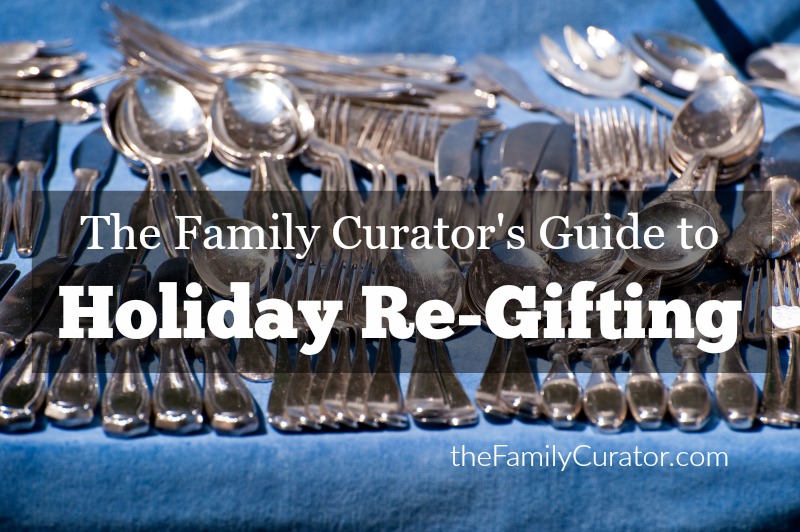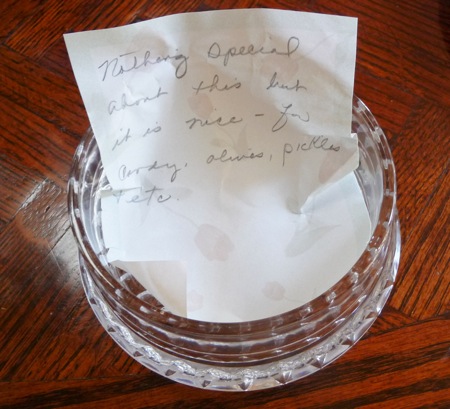How to Re-Gift a Future Family Heirloom
If you’re thinking about passing on a family heirloom this holiday season, take time to make your gift something so special that the recipient will be delighted you shopped in your family archive instead of the local mall.
My late mother-in-law was the Queen of Re-Gifting. No last-year’s fad gifts for this lady; her double-duty gifts were typically last-generation. She loved to shop at local charity thrift shops, estate sales, junk sales, department store sales. . . you get the picture.
One year, all the men in the family received multiple pairs of swimming trunks — for Christmas. They were on sale. No kidding. Even California has seasons. The women received estate jewelry — one sister-in-law opened a beautiful gold and jet brooch; another received a matching bracelet; my package held the earrings to complete the set. We took turns trying on the complete ensemble and drew straws to see who would take it home.
Three Rules of of Re-Gifting
1. Do NOT break up an heirloom set of anything.
My husband and brother-in-law celebrated birthdays a few days apart, so their mother often gave them similar gifts — shirts and pajamas were popular until she found a new thrift store specializing in estate silver, or sorta-silver. One year they each received lovely silver covered vegetable dishes, engraved with someone else’s initials. Sorry, but there is no way that the letter “S” looks like “L.”
2. Avoid other people’s names and initials.
I enjoy displaying our son’s little silver baby cups, scratches, dents and all, on a table in the dining room. My mother-in-law kindly gave brought over my husband’s silver cups to add to the collection, but she didn’t stop there. Soon, I had brightly polished baby cups belonging to Edith, Millie, and Baby Susie — and we don’t even have daughters!
I love engraved silver, but it’s much nicer when the name or monogram matches your own.
3. Consider the question: Collection or Clutter?
My mother-in-law was generous to a fault; it wasn’t her fault if your initials didn’t match beautiful engraved letters on the chafing dish.
In the days when she was still cruising the streets of Pasadena in her ’87 Olds, Mary trawled a regular route of second-hand stores in the greater Los Angeles basin. Noticing my interest in family history, she picked up several cased photographs on one excursion and gave them to me “because you like old pictures.” Instant ancestors.
My mother-in-law also appreciated beautiful handwork, and often gave me hand stitched table linens or embroidered hand towels. She recognized memories held by family keepsakes and wasn’t put off by personalization. In fact, I think she knew that often the most interesting pieces are personalized. And, what’s wrong with that? As long as there’s room to add a new initial or name, a keepsake can keep adding more history.
As the lucky beneficiaries of many re-gifted treasures it’s sometimes hard to remember what keepsakes started out “in the family” and what started out in another home. In some instances, many years have passed since these treasures moved into our house, and I can’t remember much at all about them. All of which makes me very appreciative of the few items that still hold their stories, whether it’s a handwritten note tucked inside a coffee pot or a little piece of paper in a candy dish.
One of my favorite keepsakes. No strings attached with this candy dish.
The note reads: “Nothing special about this but it is nice — for candy, olives, pickles, etc.”
Presentation is Everything
Before presenting your gift on Christmas morning, take time to write a short note to tuck inside the box. You don’t need to have perfect penmanship; your own handwritten note is a memento all by itself. Use a dark ink pen or pencil on the best quality paper you have available — old-fashioned rag paper stationery or a piece of “resume” paper will last the longest. Avoid newsprint or recycled paper.
Or download the free printable Family Curator’s Heirloom History Form to print copies on acid-free paper.
Write a conversational letter to the recipient, or just short history with bullet points, whatever style suits you best. Be sure to include —
- the date and occasion for the gift
- your name and where you live
- the recipient’s name and hometown
- how you came to own the item
- where and when it was made, if known
- why it is significant to you or your family
- why you are giving it to this person
- a description that includes size, color, shape, etc. (If the item itself is lost or becomes separated from your note, someone will know what to look for.)
You might consider attaching the note to the item in some way (on the back of a painting or piece of furniture).
A few years a go, my sister passed down our aunt’s flatware to her daughters as a Christmas gift. The silverware was cleaned and tucked inside a newly purchased wooden flatware chest with a small engraved plate naming the original owner. Each family will know exactly how and when the gift arrived.
I’ve added a brass identification plaque to our wooden Pirate Toy Chest so the future heir can find the chest’s history online at The Heirloom Registry, a website dedicated to preserving the stories that make heirlooms special. online registration of the keepsake’s history.
Photograph your treasures and place a copy of the photo and your note in your genealogy or estate papers so other family members will know what happened to this family heirloom.
This year, think about Re-Gifting a Family Heirloom. Continue a legacy, but remember –
Without the Story, It’s Just Stuff
This article was originally published in December 2013 and has been updated with new information and resources.








I recently went through my mother-in-law’s sewing tin and found several hexagons she had cut out for the quilts she loved to make. I love that she put time and thought into the selection of fabrics, so I carefully chose several and sewed them together into a hexagon flower, sewed them to a piece of linen, embroidered her name on it, framed it and gave it to her grandson and his wife. I wrote out a card explaining the significance of the piece so they will have a record as they pass it down to their children.
What a wonderful gift, Jeanne. I enjoy sewing and quilting and can only imagine what a lovely treasure this must be. Thank you for sharing the idea.
Love this! Using it in my weekly newsletter for our local society. Ho! Ho! Ho!
Please do share! And Happy Holidays to you as well.